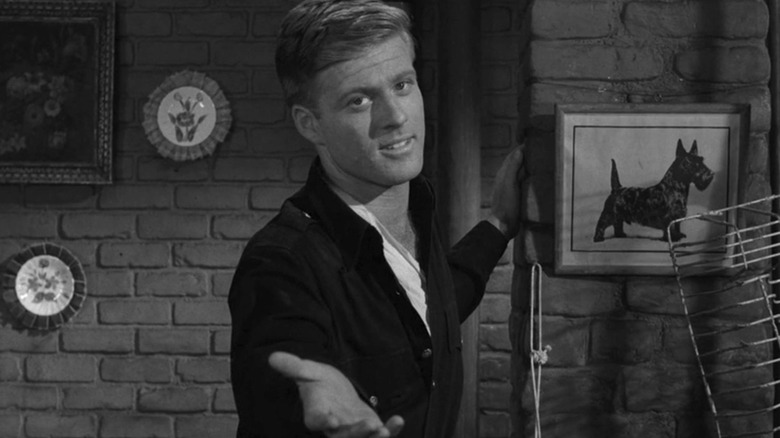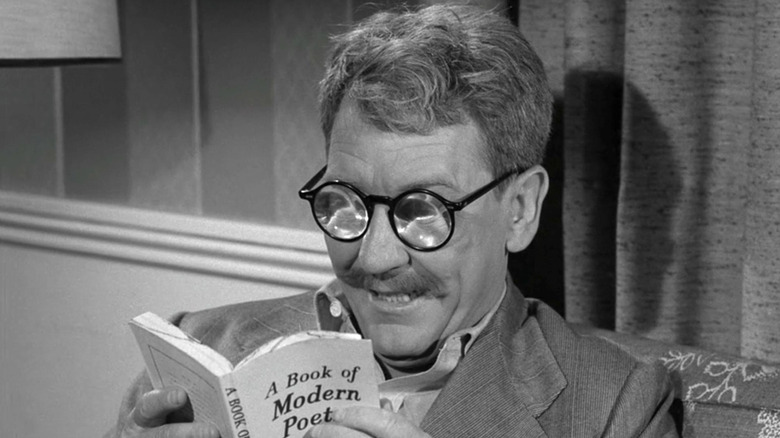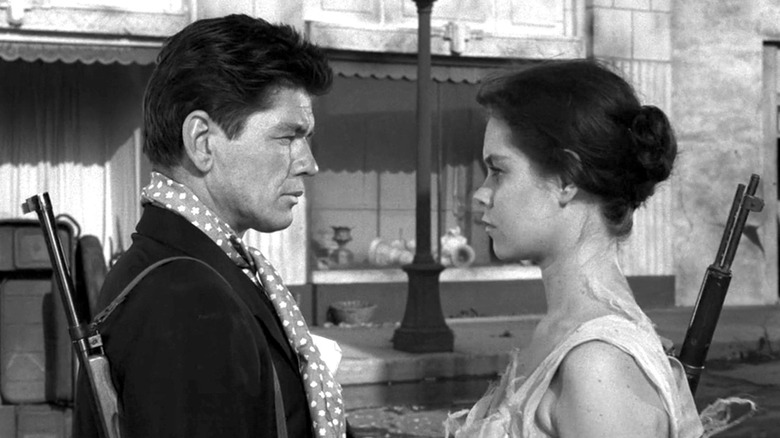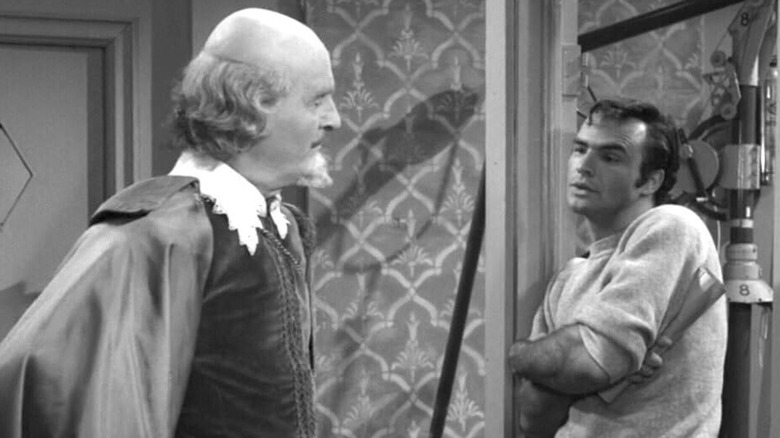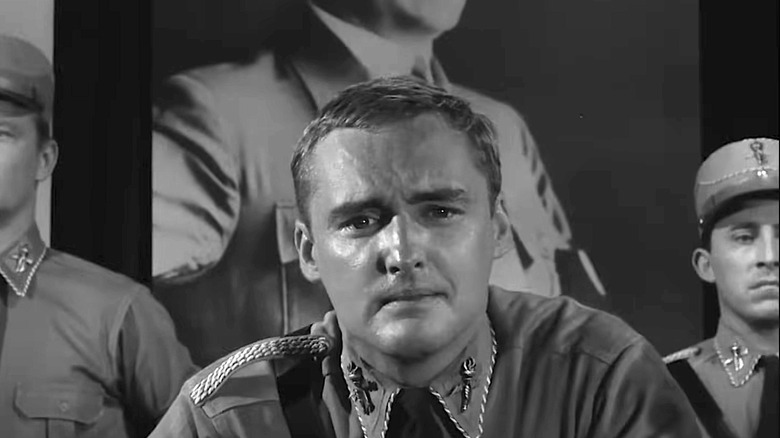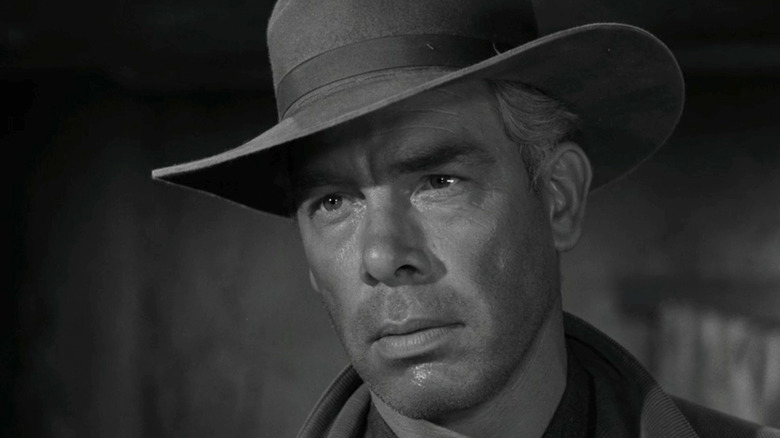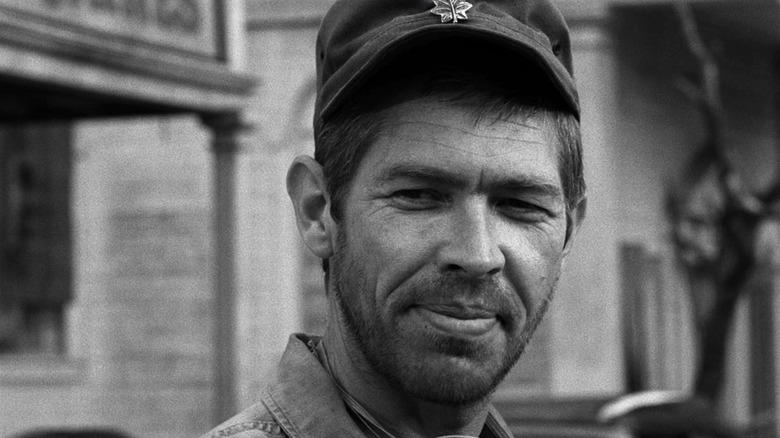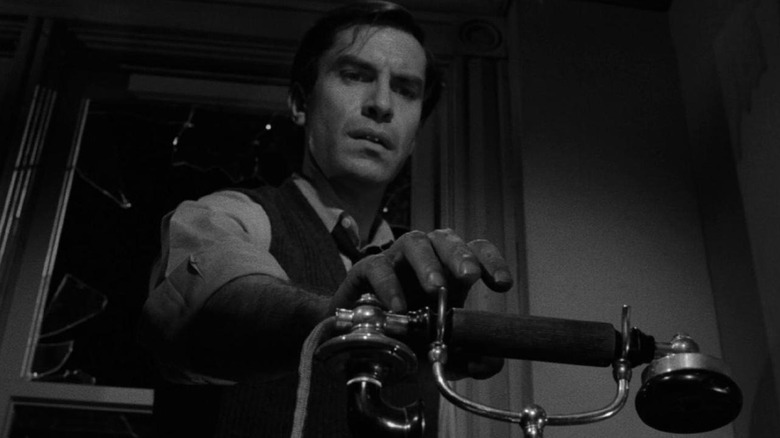10 Major Movie Stars Who Appeared On The Twilight Zone
"The Twilight Zone" was born from the brain of one of the greatest TV writers of all time, Rod Serling. For those who have never seen it, go watch it right now. For those who have, you remember it as a landmark anthology-style TV series that blended elements of science fiction, horror, drama, a touch of comedy, and subtle cultural commentary. The original "Twilight Zone" series ran for five seasons — from October 2, 1959, to June 19, 1964 — and its pop cultural influence is vast.
For starters, it spawned multiple revivals. The first one ran from 1985 to 1989; the second from 2002 to 2003 (hosted by Forest Whitaker); and the latest from 2019 to 2020, produced by Jordan Peele. Despite the credentials of the players behind these revivals, none had the same impact as the OG. But beyond the impact of "The Twilight Zone" on the medium of television was what it meant for many movie-stars-to-be. You could argue it was like the "Law & Order" of its day, where many future stars had a role on the show before they were famous. This list is a "who's who" of future Academy Award winners and cinematic legends. But they all got their start in the fifth dimension, a place between light and shadow, a place known as... "The Twilight Zone."
Robert Redford
The late, great Robert Redford had a remarkable run as one of the biggest movie stars from the late 1960s all the way through the late '80s. Redford introduced a permanent pop culture mainstay with "The Horse Whisperer" in the '90s, got top billing over Brad Pitt in the early 2000s with "Spy Game," and was a bad guy in the Marvel Cinematic Universe. Dude had staying power. But what else would you expect from the star of such seminal hits as "All The President's Men," "The Great Waldo Pepper," "Jeremiah Johnson," "The Way We Were," "Three Days of the Condor," and his two masterpieces with Paul Newman, "Butch Cassidy and the Sundance Kid" and "The Sting"? He was also an Oscar-winning filmmaker, cementing his legendary status behind the camera on "Ordinary People," "A River Runs Through It," and "Quiz Show." But it all started in "The Twilight Zone."
"Nothing in the Dark" premiered on Jan. 5, 1962, and starred Gladys Cooper as a frail, elderly woman so terrified of death she lives as a hermit. When a charming young man (Redford) appears outside her door, she must decide whether or not to help him. While most women would be delighted to entertain Redford, this time the handsome lothario is actually Death itself. So basically the "Final Destination" movies, but without the gore. "Nothing in the Dark" was one of the most memorable episodes of "The Twilight Zone," and not just because it helped launch Redford's legendary career.
Burgess Meredith
Beloved character actor Burgess Meredith was active from the '30s all the way to his death in 1997. Meredith was an "actor's actor," and his career included stints in theater, radio, film, and television. You're most likely to remember him today as Rocky Balboa's trash-talking, no-nonsense trainer Mickey Goldmill in the first three "Rocky" movies (plus a cameo of sorts as an inspiring apparition in "Rocky V"). The role earned Meredith one of his two Oscar nominations (he never won), for Best Supporting Actor in 1977. Unlike many of the others on this list, Meredith didn't get his start on "The Twilight Zone," as he had been working steadily for almost 30 years. Rather, his appearance was truly the definition of a guest "star," and gave credibility to the show.
Meredith starred as Henry Bemis, a mousy, bespectacled man bullied and belittled by everyone in his life; he desires nothing more than to enjoy his books, but is surrounded by people who prevent him from reading them. Bemis seems to get his wish when he is locked inside a bank vault, saving him from nuclear winter. He emerges with "Time Enough at Last" (the title of the episode) to savor his reading, but as with everything in the "The Twilight Zone," there is a catch. "Time Enough at Last" was the eighth episode, premiering on Nov. 20, 1959, but as the most famous episode of the first season, its impact was timeless.
William Shatner
So we know what you're thinking: "Isn't William Shatner more of a TV star?" Fair enough, as his greatest claim to fame was playing Captain James Tiberius Kirk in the original "Star Trek" series, as well as T.J. Hooker in the TV show of the same name in the 1980s. But c'mon, it's William Shatner. He starred in tons of movies, including appearing as Captain Kirk in seven "Star Trek" films. Besides that, his resume is filled with movie work both before and after he ventured into the final frontier. So he definitely counts as a movie star. He also appeared in one of the most iconic "Twilight Zone" episodes of all time: "Nightmare at 20,000 Feet."
The third episode of the fifth season (directed by Richard Donner) was based on a short story by Richard Matheson of "I Am Legend" fame, and premiered on Oct. 11, 1963. Shatner plays a man terrified of flying even in wonderful weather. Trouble is, his flight is not only plagued by wicked storms, but by a hideous creature known as a gremlin. Shatner's sui generis style of acting is on perfect display in this episode, as he is delightfully over the top for what can only be described as an outrageous scenario. But here's the thing: It worked. It worked so well that this episode was one of only four remade for the "Twilight Zone" movie in a segment directed by George Miller and starring John Lithgow in the Shatner role.
Robert Duvall
While high-profile thesps like Robert De Niro, Daniel Day Lewis, Meryl Streep, and more get all of the accolades and plaudits, Duvall has always just been over there doing his thing, stealing the show in pretty much every movie he has ever been in. And the dude has been in some of the best: "The Godfather," "The Godfather Part II," "Apocalypse Now," "The Conversation," (swear it's not just Francis Ford Coppola movies), "The Great Santini," "Network," and undeniably the best of them all, "Gone In 60 Seconds." But before Duvall put himself on the shortlist for the G.O.A.T., he fell in love with a doll in "The Twilight Zone" (as one does).
In the aptly titled episode "Miniature," Duvall plays Charley Parkes, a mousy misfit overburdened by his boring job who believes that a doll in a museum comes to life. "Miniature" was episode eight of Season 4 of "The Twilight Zone," and premiered on Feb. 21, 1963. It's not the most memorable episode of "The Twilight Zone" and is more remembered today for featuring Duvall. Released one year after his role as Arthur "Boo" Radley in 1962's "To Kill A Mockingbird," these early roles showed the range that made Duvall one of the best.
Charles Bronson
Charles Bronson was a late bloomer in the movie business, not hitting major movie stardom until 1974's "Death Wish" when he was in his early 50s. At that point, Bronson became one of the biggest and most well-paid movie stars in the film business, and was even considered for the role of the big, blue boy scout in "Superman: The Movie" (yes, that sounds as weird to us as it does to you). But before "Death Wish," Charles Bronson had supporting roles in "The Magnificent Seven," "The Great Escape," and "Once Upon a Time in the West." He was a standout on the small screen, as well, including in "The Twilight Zone."
The episode is "The Two," and first aired on Sept. 15, 1961, the Season 3 premiere. Bronson plays "The Man," opposite Elizabeth Montgomery (of "Bewitched" fame) as "The Woman." These two characters are named that for a reason; they are the last two survivors of an apocalyptic nuclear war that has sent humanity into extinction. Not only that, but the two are from opposing sides of the conflict. It's a solid episode that had the nerve to face head-on the cataclysmic nightmare of nuclear apocalypse 22 years before "The Day After," and a year before the Cuban Missile Crisis. Terror was in the air, but so was love, as the Man and Woman find there's nothing left to fight over when both of their countries are wiped away.
Burt Reynolds
Burt Reynolds was in the running for the biggest movie star of the '70s for movies like "Smokey & The Bandit" and "The Longest Yard." With a mustache more famous than most other movie stars, Reynolds was as close to a sure thing at the box office during that decade as you were going to get. But Reynolds was also in living rooms across the nation when he appeared in "The Bard," the 18th episode of "The Twilight Zone" Season 4.
In the episode from May 23, 1963, Julius Moomer (Jack Weston) is a talentless wannabe writer whose shameless self-promotion never lands him his dream gig of writing for TV. That is, until he summons the ghost of William Shakespeare (John Williams) to write TV teleplays for him. Surprising nobody, The Bard is horrified not only at this hack's appropriation of his works, but even more so at the greedy TV execs. Unlike others on the list, Reynolds' role was not a starring performance, but a supporting part. He briefly plays Rocky Rhodes, a method actor based on Marlon Brando, which plays well in this satirical episode.
Dennis Hopper
Dennis Hopper helped change film history with his directorial debut "Easy Rider" in 1969. Hopper and his co-star/producing partner Peter Fonda brought the '60s counterculture to mainstream on the big screen, while employing cinema verité methods (borrowed from European directors) that would go on to inspire the New Hollywood generation of directors like Martin Scorsese, Robert Altman, Francis Ford Coppola, Hal Ashby, and Steven Spielberg. However, Hopper was no newbie, and had been bouncing around Hollywood for some time with small parts in movies like "Rebel Without a Cause," "Giant," "Cool Hand Luke," and "True Grit" (which came out one month before "Easy Rider").
As a young actor trying to make a living, Hopper also took on TV work, such as "The Twilight Zone." "He's Alive" was Episode 4 of the fourth season of "The Twilight Zone," and premiered on Jan. 23, 1964. Hopper plays Peter Vollmer, leader of a '60s neo-Nazi group that is struggling to recruit new members. However, things turn around when Vollmer is visited by a mysterious figure who begins to guide him to greater success. Wouldn't you know it, turns out the mysterious figure is actually the ghost of Adolf Hitler. Rod Serling wrote the story himself and hoped to turn it into a feature-length film. That didn't happen, so we're glad it exists as a memorable episode of "The Twilight Zone."
Lee Marvin
With his unconventional grizzled looks and gravelly, gritty voice, Lee Marvin didn't exactly fit the mold of a traditional Hollywood leading man. But while Marvin never looked like he came from central casting, he became a major movie star playing rough and tough characters that suited his strengths as a film actor. His most famous roles were as the titular "Man Who Shot Liberty Valance," followed by "The Killers," "The Professionals," "The Dirty Dozen," and "The Big Red One." (There was also "Paint Your Wagon," where he and Clint Eastwood sang, but we try not to talk about that one.) Marvin was an unconventional leading man, but he was the perfect character actor, especially for Westerns, which were still thriving on the big and small screens at that time.
Naturally, Marvin's first role in "The Twilight Zone" was in a Western. In "The Grave," Marvin plays a lawman who gunned down an outlaw, who pledges to drag him into his grave. Marvin's work on the Season 3 episode, which premiered on Oct. 27, 1961, must have impressed producers, as Marvin was hired again for the Season 5 episode "Steel." Premiering on Oct. 4, 1963, Marvin plays Tim "Steel" Kelly, a former pugilist who agrees to fight a robot once boxing has been outlawed. So Marvin was on not one, but two episodes of "The Twilight Zone," and each is well worth a watch.
James Coburn
James Coburn's nearly half-a-century career was crowned with an Academy Award for Best Supporting Actor for 1999's "Affliction." Even with that feather finally in his cap, Coburn continued to work for another three years until his death in 2002 at 74 years old. Coburn left behind a monumental body of work, tracing back to the '50s. His filmography included such gems as "The Magnificent Seven," "The Great Escape," "Charade," "A Fistful of Dynamite," and "Pat Garrett & Billy The Kid." Naturally, his 45 years on the screen also included a stop in "The Twilight Zone."
Coburn starred in "The Old Man & The Cave," Episode 7 of the final season of "The Twilight Zone," which premiered on Nov. 8, 1963. "The Old Man & The Cave" was set in a post-apocalyptic settlement in the future, 1974, and showed how little hope the writers of "The Twilight Zone" had for humanity. Coburn plays Major French, a violent soldier who attacks the small settlement, whose only hope for survival rests on the sage advice of the titular unseen man living in a nearby cave. Coburn is at his snarling and sneering best in this episode, giving life to one of the great villains on the show. "The Old Man & The Cave" was written by Rod Serling himself, and is one of the last great standouts of the series, thanks most notably to its star, Coburn.
Martin Landau
Martin Landau had an incredible 60-year career in theater, film, and television. He got his start playing the sniveling lackey to James Mason's suave villain in Alfred Hitchcock's "North By Northwest" in 1959. Landau's breakthrough came with a starring role in the original "Mission: Impossible" TV series, which he was on from 1966-1969; he later starred in the less-remembered (but popular at the time) British sci-fi show "Space: 1999" from 1975-1977. Along the way, he put together an equally impressive body of work in film, including memorable supporting roles in "Nevada Smith," "Tucker: The Man & His Dream," "Crimes & Misdemeanors," "Sleepy Hollow," and "Ed Wood," the latter of which won him an Academy Award for Best Supporting Actor.
Landau's stint in "The Twilight Zone" was one of the last episodes of the last season of the seminal series. "The Jeopardy Room" was Episode 29 of Season 5, and premiered on April 17, 1964. Landau plays Russian defector Ivan Kuchenko, who is trapped in a room with only three hours to locate a hidden bomb. His captor, Commissar Vassiloff (John van Dreelen) doesn't just want to execute Kuchenko, but turn his demise into an art form. Besides featuring Landau, "The Jeopardy Room" is also one of only a few episodes of "The Twilight Zone" to feature no science fiction or supernatural elements. It's just good old-fashioned suspense, brought to life by the sheer talent of its star, Landau.

